Phleng Luk Thung: Thai Country Music

The soulful music of Phleng Luk Thung [เพลงลูกทุ่ง] that plays after a click from a cassette player brings back old memories of the 20th century when the genre peaked in popularity. But Phleng Luk Thung, or Thai country music, is more than just a nostalgic artifact of the past. It is a living, evolving genre that continues to capture the hearts and minds of people in Thailand and beyond. Today, this article will explore what Luk Thung means, from its definition, and characteristics, to the rich history that makes it a beloved genre of all generations.
What defines Luk Thung?
Phleng Luk Thung draws inspiration from Thai folk music and contemporary musical elements. They are composed in a language that resonates with grass-root people, yet is full of linguistic beauty and sentiment as it explores themes of Thai culture, values, country lifestyle, and social challenges from the perspective of working-class people, particularly those from the rural areas. The word Luk Thung in Thai means “Child of the Fields,” referring to those who grow up in the rural countryside, in contrast to Luk Krung (Child of the City), another genre of Thai music in the past, which centers around stories of urban lifestyle and experiences in the capital.
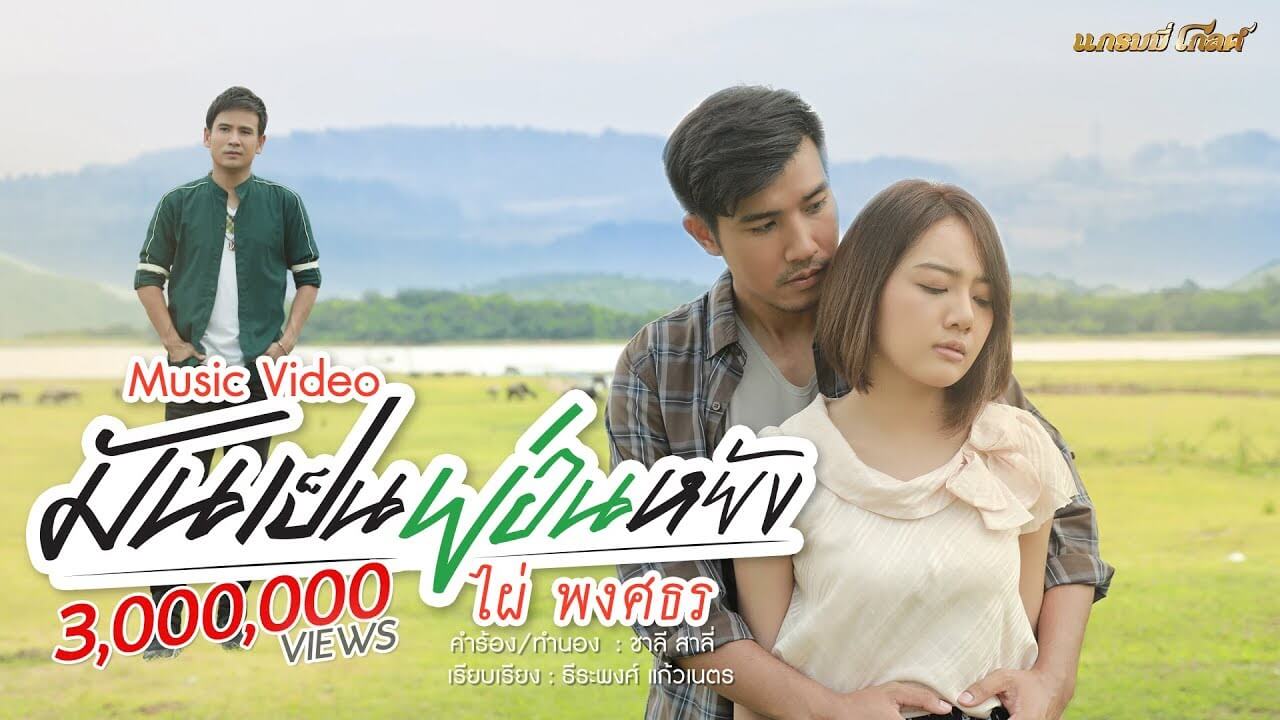
A Luk Thung music video featuring image from the countryside
(cr. Grammy Gold Official)
The lyrics of Luk Thung songs are renowned for their poetic quality, which usually follows traditional Thai poetic composition rules. These lyrics are performed with a clear and full-range voice, or with a technique known as “luk kho” [ลูกคอ], which is a style of vibrato. The regional dialects of the singers also add to the charm and uniqueness of each performance.
Besides the rich vocalization, Luk Thung is also known for its vibrant performance that features “hang khrueang” [หางเครื่อง], a term referring to dancers in colorful, eye-catching outfits and larger-than-life accessories such as big flowers, feathers, and wings. Along with powerful audio systems, beaming lighting, and decorated backdrops, the concert is filled with lively energy from the performers and the crowd. In rural regions of Thailand, Luk Thung concert serves as a socializing space for people to gather and enjoy the jolly atmosphere. The performance is very interactive and the audience can show their appreciation by giving flower garlands or garlands made out of bank notes to the performers.
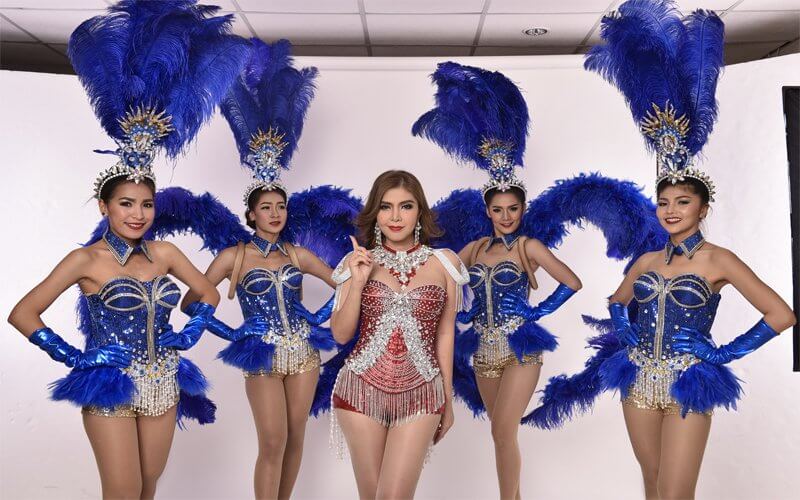
Singer with hang khrueang (cr. Highlight-DD)
Luk Thung by Region
The Luk Thung genre varies in different styles, especially regionally. Luk Thung music coming from different parts of Thailand are characterized by the region’s history, traditions, and geography. Here are some examples:
- Central Thai Luk Thung
Central Thai Luk Thung is one of the most influential styles of Luk Thung. It originated from the folk songs in the region such as Phleng Choi, Phleng E-Saew, and Phleng Ruea. For example, Phleng Ruea (Thai Boat Song) is a traditional song that captures the lively spirit of the river lifestyle and showcases the community’s positive outlook through a song even during flood season. These traditional folk songs are often performed in a call-and-response style between male and female singers. This certain singing style is particularly well-suited to the unique intonation of the central Thai accent, which features a distinctive pattern of low and high pitches. When complemented by Western instruments, it makes the melody of this subgenre even more uniquely charming.
Traditional instruments used in the Central Thai Luk Thung songs may include klong yao (long drums), ranat (Thai xylophone), ching (cymbal), and krab (wooden clappers) that are combined with western instruments such as drum, guitar, etc.
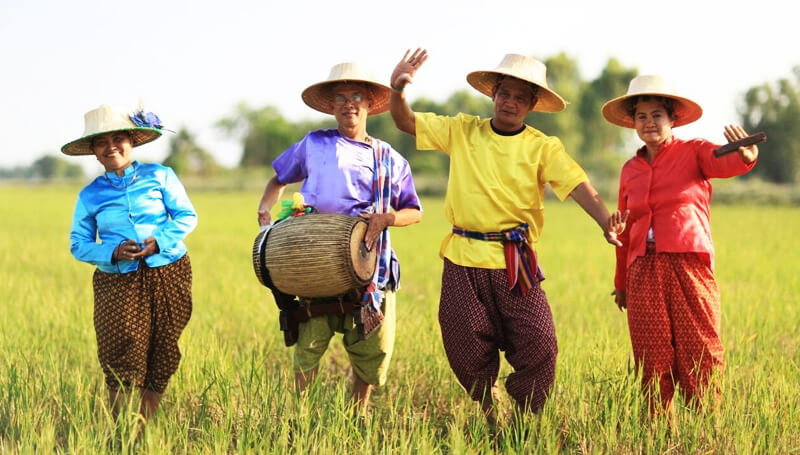
Central Thai folk singers (cr. Annop.me)
With such unique vocal styles, the central region is home to many great Luk Thung singers such as Suraphol Sombutchareon, Waiphot Phetsuphan, Sayun Sunya, and many more. These are all classic icons of Luk Thung singers from the Golden Age who had risen in fame during their peak popularity and still have a lasting impact on the music industry nowadays.
Waiphot Phetsuphan, or the King of Phleng Lhae (Sermon Song), was regarded as the national artist of Luk Thung music. Waiphot was known for his vocal talent in performing a wide range of folk songs while he could also recite Buddhist sermons. He was a music teacher to many new generations of stars such as Pumpuang Duangchan, the all-time Queen of Luk Thung music.
- Isan Luk Thung
Isan, or Northeast Thailand, is a large region that shares many cultural links with its neighbor: Laos. The rhythm and melody of Isaan Luk Thung are from Mor Lam (traditional Northeastern music) and serng (a kind of dance). The original rhythm of these folk songs is often performed in a fast-paced, lively, and very festive manner.
Lyrics of Isan Luk Thung is also characterized by its distinctive Isan dialect. Traditional instruments used in performance may include khaen (bamboo mouth organ) or pong lang (wooden xylophone).
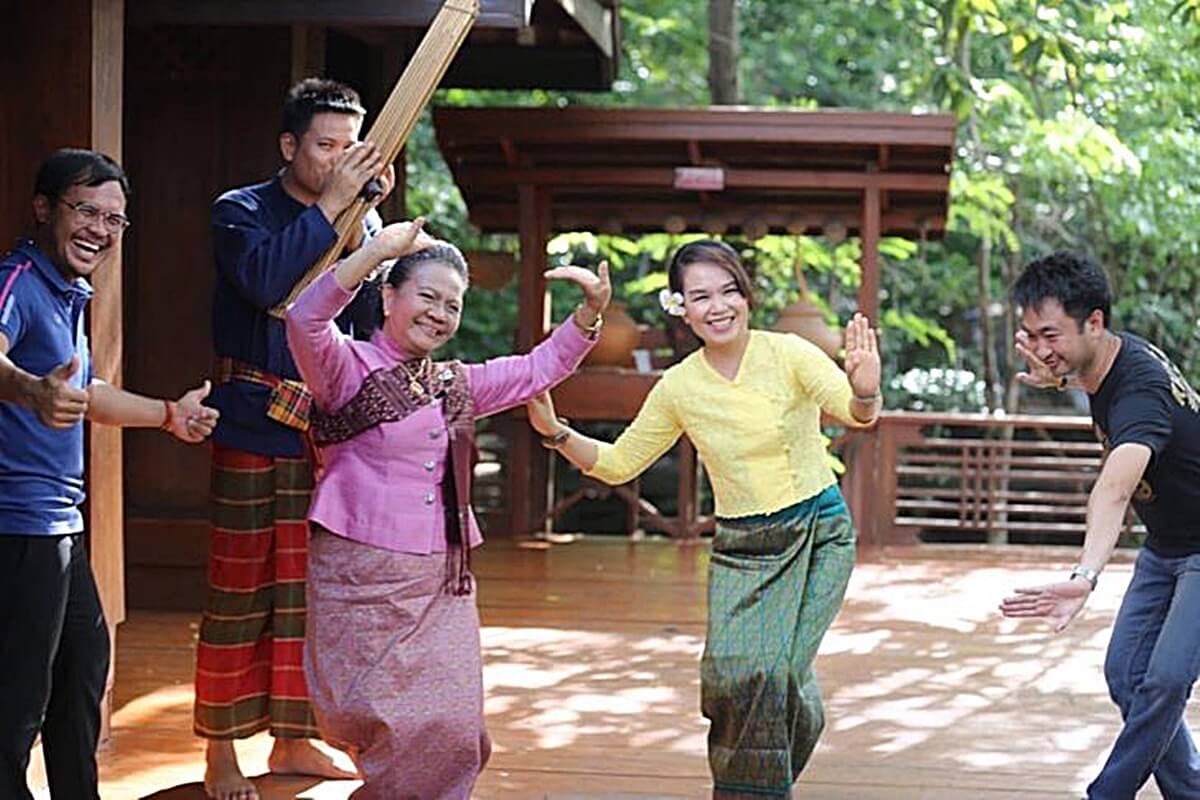
Mor Lam performance (cr. Matichon Academy)
Today, Isan Luk Thung is one of the most famous subgenres with a wide-reaching audience that does not only include Thais but also international fans from neighboring countries, and even overseas Thai and Lao communities. It is a vibrant industry of shared experiences, similarities in languages, and ways of life that makes the genre popular. One of the most iconic singers from the region is Jintara Poonlarp who is known for her upbeat music and distinct Isaan dialect lyrics. As of now, she has more than 3.63 million subscribers on her official YouTube channel with 1,532,920,480 views in total. Her new releases and all-time classics continue to grow and attract new and returning audiences.
Another star from the Isaan region today is Monkaen Kaenkoon. Coming from a humble background in the rural country of Yasothon, Monkaen became one of the most famous Luk Thung singers who has been awarded YouTube’s Most Streamed Artists for three consecutive years. In 2020, Monkaen’s songs have gained 808 million views on the platform. Despite the current trend in pop music that becomes a worldwide mega-hit, Monkaen’s unique Isaan Luk Thung music still makes waves in the industry and is very much loved by many audiences, especially among working-class people. An example of his popular song is Ngan Taeng Khon Jon (Marriage of the Poor) which tells a simple, yet pure, love story between a young couple coming from a poor background. It is one of Monkaen’s music videos that reached over 217 million views in 2023.
- Luk Thung Kantrum (Isaan-Khmer-Style Folk Song)
Southern Isan is a diverse region, populated by the major ethnic groups of Thai, Lao, Khmer, as well as communities of Kuy and Yer peoples, among others. Kantrum [กันตรึม] is a type of folk music of the ethnic Khmer people who reside in the area. It is performed at weddings, funerals, and religious rituals. The lyrics can be sung both in Thai and Northern Khmer (a variation of the Khmer Language spoken in Southern Isan).
As Luk Thung gained popularity throughout Thailand, the Southern Isaan region also began incorporating Western instruments into their unique musical identity, resulting in the creation of the region’s distinct subgenre known as Luk Thung Kantrum. The style is characterized by the incorporation of soulful melody, usually from tro (Khmer fiddle) with deep, grooving rhythms of skor (Khmer drum) and modern instruments such as electronic keyboard, guitar, and bass.
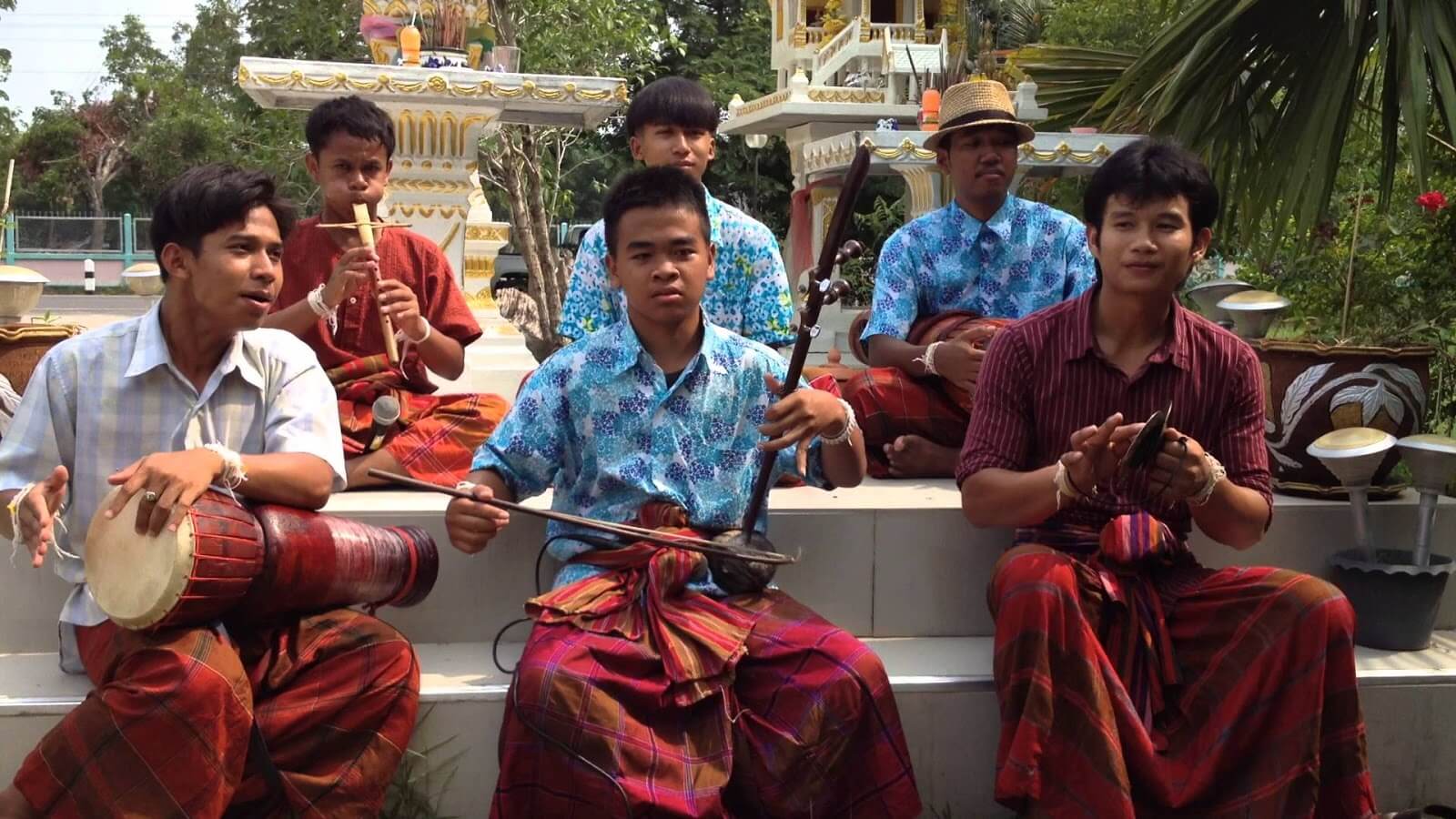
Kantrum ensemble (cr. khmer-music-live.blogspot.com)
Many artists who are known for their Luk Thung Kantrum styles are such as Rock Khong Khoy (ร็อคคงคย), who incorporate rock music with traditional instruments, creating a unique upbeat rhythm that is exclusive to the region. Most of Rock Khong Khong’s songs are written in Khmer, although some are mixed with Thai. For example, Jerd Ei Jerd (O, My Heart) is fully in Khmer. But the song is very much loved and enjoyed by the other Isaan communities and beyond.
- Luk Thung Kam Mueang
Luk Thung Kham Mueang [ลูกทุ่งคำเมือง] originated in the Northern region of Thailand. This Luk Thung utilizes the Northern Thai (Lanna) dialect, also known as Kham Mueang [คำเมือง], which is known to be soft and gentle sounding. This subgenre is similar to Western folk music but it integrates melodies of salor (Northern Thai fiddle) with Western instruments such as acoustic guitar, producing clear and soothing sounds just like the Northern people who are soft-spoken.
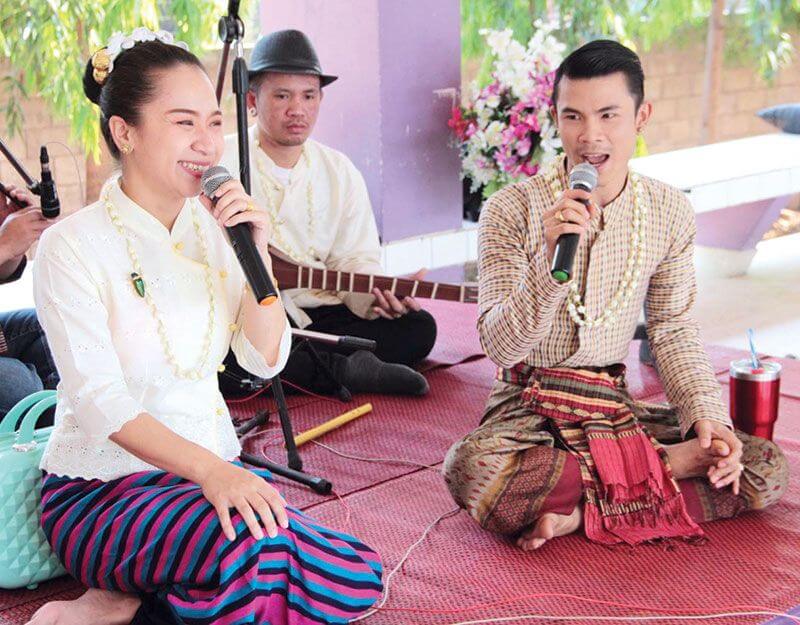
Northern Thai folk singers (cr. Naewna)
Jaran Manophet, also known as King of Kham Mueang Folksong, is regarded as one of the greatest artists from Chiang Mai Province. His lyrics are rich in the local dialect and culture. For example, in the song Baan Bon Doi (House of the Hill), he recounts life on a remote hill village, where amenities may not be abundant, but kindness from the locals can always be felt. Another famous singer is Soontaree Vechanont, whose iconic song Long Mae Ping (Sailing in the Ping River) praises the natural beauty of the North and the virtues of Northern women.
- Southern Thai Luk Thung
Southern Thai Luk Thung also features its dialect, melody, and style from its regional folk songs and theatrical performances such as Nang Talung (shadow puppetry). The Southern Thai accent is known for its thick, concise, but fast tempo that goes well with traditional instruments used for upbeat and rhythmic sounds such as mhong (gong) and drums.
Chatthong Mongkhonthong is known as one of the most well-regarded classic Southern Luk Thung artists from Nakhon Si Thammarat. Many of his great songs portray a vivid story of Southern people living by the seaside. For instance, Num Auan Lak (A Man with Fish Net) tells the perspective of a fisherman who has been separated from his lover as he was sent on duty to the ocean.
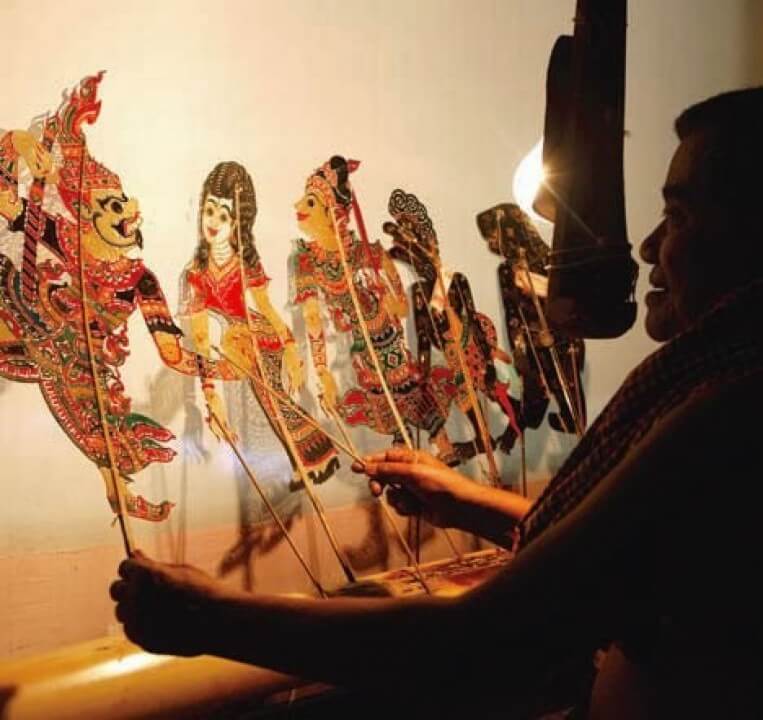
Nang Talung (cr. Krabi Municipality)
The Southern region is also home to many other talented Luk Thung artists, including Ekkachai Srivichai. Today, the artist is often called “The No.1 Southern Thai Singer” by his proud fans. Ekkachai’s passion for his Southern Thai heritage led him to form the band Srivichai Show, which celebrates the rich culture of his beautiful hometown. His performances are known for their funky instruments and playful energy. For instance, his popular song Mah Gad (Dog Bite), which has sold over 2 million copies and brought him popularity, is a lively tune that is sure to get listeners on their feet and dancing along.
Nowadays, Ekkachai has also contributed to the success of many other southern Luk Thung singers, including Duangjan Suwannee, Luang Gai, and Jeab Benjaporn.
From Past to Present
As mentioned earlier, Luk Thung originates from a continuation of folk and traditional music that has undergone Western influences and changes over time. But when did Luk Thung begin? The genre can be traced back to the time when Eua Sunthornsanan, a Thai singer and composer, brought Western music into Thai culture. This paves the way for Phleng Thai Sakon (international-style Thai music) which refers to a genre that incorporates Western instruments and traditional music. Phleng Thai Sakon, then, found its way to singers in the countryside and the city, leading to the birth of Luk Thung and Luk Krung respectively. Initially, pioneer country singers such as Kamron Samboonnanon and Suraphol Sombutchareon were referred to as “nak rong talad” or “down-to-earthsingers, as their songs were written in colloquial language and themes revolving around simple countryside life that resonated with rural audiences.
The genre was later widely known as “Luk Thung” when the term was first introduced through a TV show named “Pleng Luk Thung”, which aired on Channel 4 Bangkunphrom. The show featured performances by folk-inspired artists and musicians. Following the show’s popularity and success, the artists began referring to themselves as Luk Thung singers or Luk Thung bands. During these early eras, the Luk Thung music scene was highly competitive. These singing competition TV shows provided an opportunity for artists from all over Thailand to showcase their talents and gain recognition. To stand out, many composers and artists had to distinguish their music from others and find a unique style.
The ever-evolving development of Luk Thung songs from the past until the present can be summarized using different eras and the distinct themes and styles of Luk Thung songs during each period, as follows:
- The First Generation of Luk Thung (1938-1964)
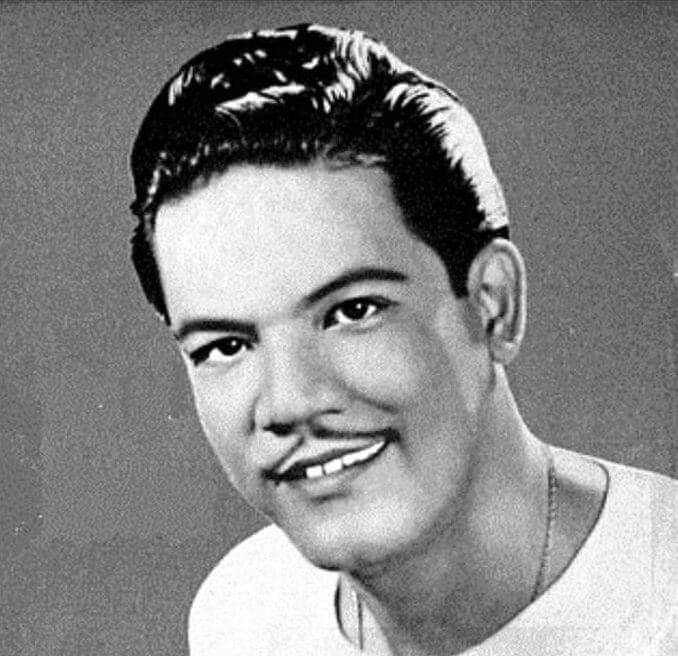
Kamron Samboonnanon (cr. Wikipedia)
When Luk Thung music was first introduced, the genre discussed straightforward concepts of rural life, such as the beauty of the countryside, love stories, as well as religious beliefs and norms.
For example, Jao Sao Chao Rai (The Farmer’s Bride) by Kamron Samboonnanon, portrays a love story between rural boys and girls. This song uses a physical landscape of wide rice fields to emphasize the loneliness of the boy. It is regarded as the first song in the Thai Country Music industry.
- The Golden Age of Luk Thung, and Luk Thung in Movie (1964-1972)
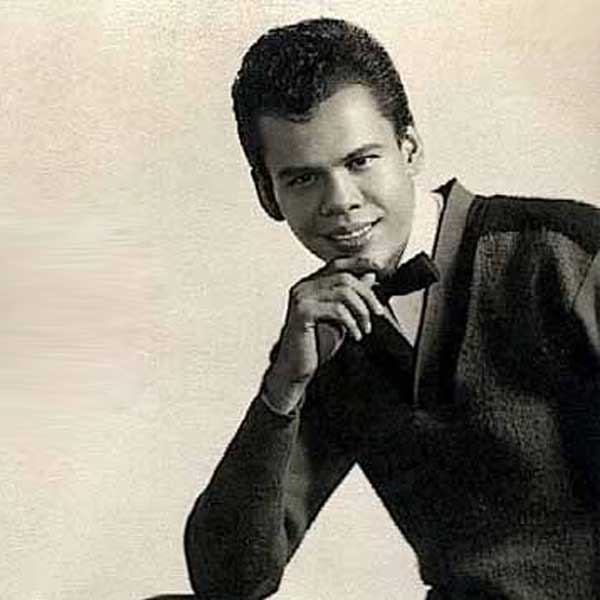
Suraphol Sombatcharoen (cr. Dochord.com)
Later on, Luk Thung quickly gained popularity and peaked at its highest point as it was broadcasted on TV shows. It was also featured as a soundtrack in a movie, making the genre reach a wider audience while being known as its Golden Age. Meanwhile, the theme of the song has a slight change in tone that became more vibrant, humorous, and even satirical.
During his active years, Suraphol Sombatcharoen or “King of Luk Thung,” was regarded as one of the most influential figures that contributed to the highest popularity of Luk Thung music, making the period known as the Golden Age era. Suraphol had a unique musical style, exceptional talent in songwriting, and a charming voice like no other. Most of his songs are fun and lively, but can also be emotional. Hua Jai Phom Wang (My Heart is Available) is a perfect example of Suraphol Sombatcharoen that captures people’s hearts and brings them joy. Suraphol passed away in 1968. His death marked the shift in the Luk Thung industry and allowed more rising stars to have their own debuts.
Other famous artists in the era are Waiphot Phetsuphan and Sayun Sunya. One of Waiphot’s famous songs is Na Nha Tong (Glided Face) which features a magical incantation in the chorus to help the singer manifest luck in love. It is a fun and lively song that shows how Thai people use religious beliefs as a source of comfort and enjoyment.
Another classic example is Sayun’s Dae Kon Chue Jeab (To the Person Named Jeab) It is a longing love song that incorporates the soulful sound of jazz music, which adds an even more melodious and dreamy quality to the lyrics for his unrequited love.
With more rising stars coming to the scene of the Luk Thung music industry, aspiring artists from regions across Thailand also had a chance to produce their music in Bangkok for the first time. For example, many talented local artists, such as Mor Lam Boon Peng, Foong Suk, Mor Lam Ken, and Dar Lao from the Isan region, had the chance to record and publish their music in Bangkok. Their contributions helped to increase the popularity of Mor Lam Isan, and their fun and upbeat performances became hits, earning frequent airplay on radio channels and appearances on TV shows.
Additionally, many popular northern Luk Thung artists also recorded their tapes for the first time in Bangkok, including Siripong Srikosai (Ya Boon) who led his local band Srisompetch and produced their debut song Yen Rue Dee (Cooling to the Heart). His dedication to Lanna’s music made Luk Thung Kam Mueang’s style become widely popular throughout Thailand.
- The Era of Puea Chi Wit Luk Thung (1973-1976)
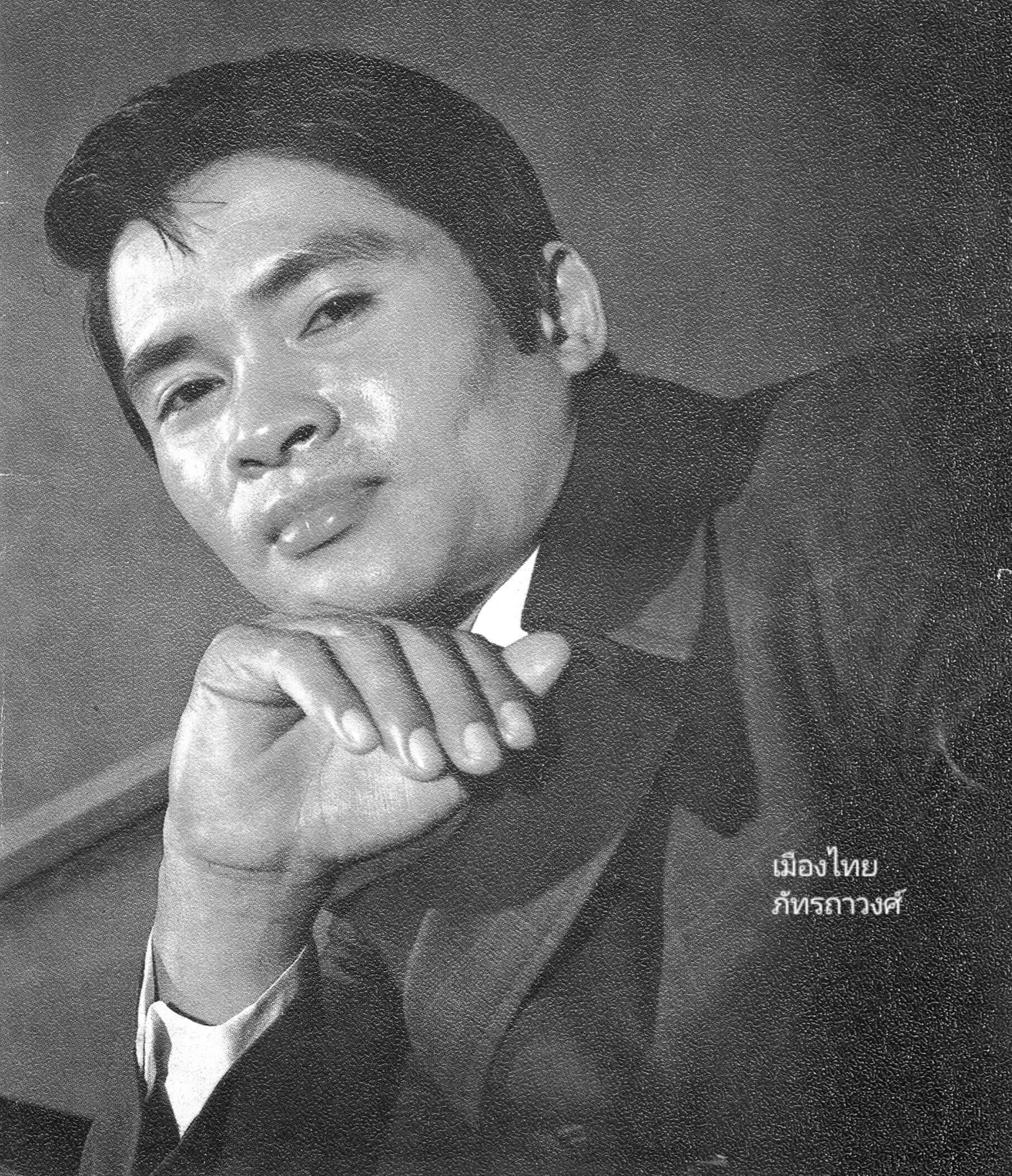
Phloen Phromdaen (cr. Wikipedia)
During 1973-1976, a new genre called Phleng Puea Chi Wit or “Music for Life” emerged, becoming popular for addressing social issues. Phleng Luk Thung also adopts this influence with the lyrics becoming more critical and addressing the working class struggles with social instability. For example, Khao Mai Mee Khai (No Rice for Sale) by Sornphet Sornsuphan dealt with the frustrations of farmers suffering from crop failure.
Additionally, there has been a new trend of inserting a monologue or dialogue (Phleng Pood) in the song during this period. It may discuss social situations or mundane life issues in a humorous way. Popular artist such as Phloen Phromdaen has many famous songs that address various social issues. For example, Lueak Tang Phu Wah (The Election) is a fun and playful song that encourages people to exercise their rights and vote for a good governor. Phloen’s mastery of language and entertaining style makes most of his dialogues smooth and flow well with the song, giving an enjoyable experience for the audiences who can listen to it for hours long; they can listen “Phloen Phloen” (meaning: enjoyably in Thai), just like the singer’s name.
- The Era of Hang Krueng and Concert (1976 – 1985)
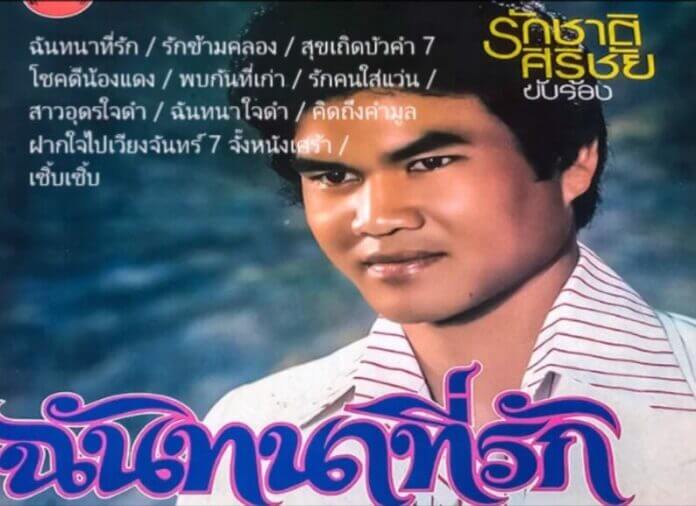
Rakchart Sirichai (cr. Khao Sod)
Around 1976, Thailand continued to undergo a period of instability. While Phleng Puea Chi Wit’s popularity decreased, newer Luk Thung stars emerged. And the Luk Thung market became highly competitive, with more investment in stage performance such as lighting, sound technique, and dancers. At the same time, the themes during this era reflect the struggle of workers as they adapt to new lifestyles and face challenges outside of their familiar, humble hometowns in pursuit of better opportunities in the capital or abroad.
For example, Pimpa Pornsiri’s Nam Ta Mia Sa U (Tears of A Wife) portrays a perspective of a woman whose husband is working abroad for their family. Meanwhile, Rakchart Sirichai’s song of Chantana Tee Ruk (My Dear Chantana) is a love letter from a man to his lover who has been working in a town factory.
During the previous era of Luk Thung music, there was a widespread belief that Luk Thung singers should not sing off-tune and should mimic the accent of people in the city. However, the later generation artists often featured and highlighted their local dialects in the music. For example, Chatthong Mongkolthong is one of the Southern Luk Thung artists who was well-known for his fun concert and unique dialect.
- The Era of String Luk Thung (1985 – 1992)
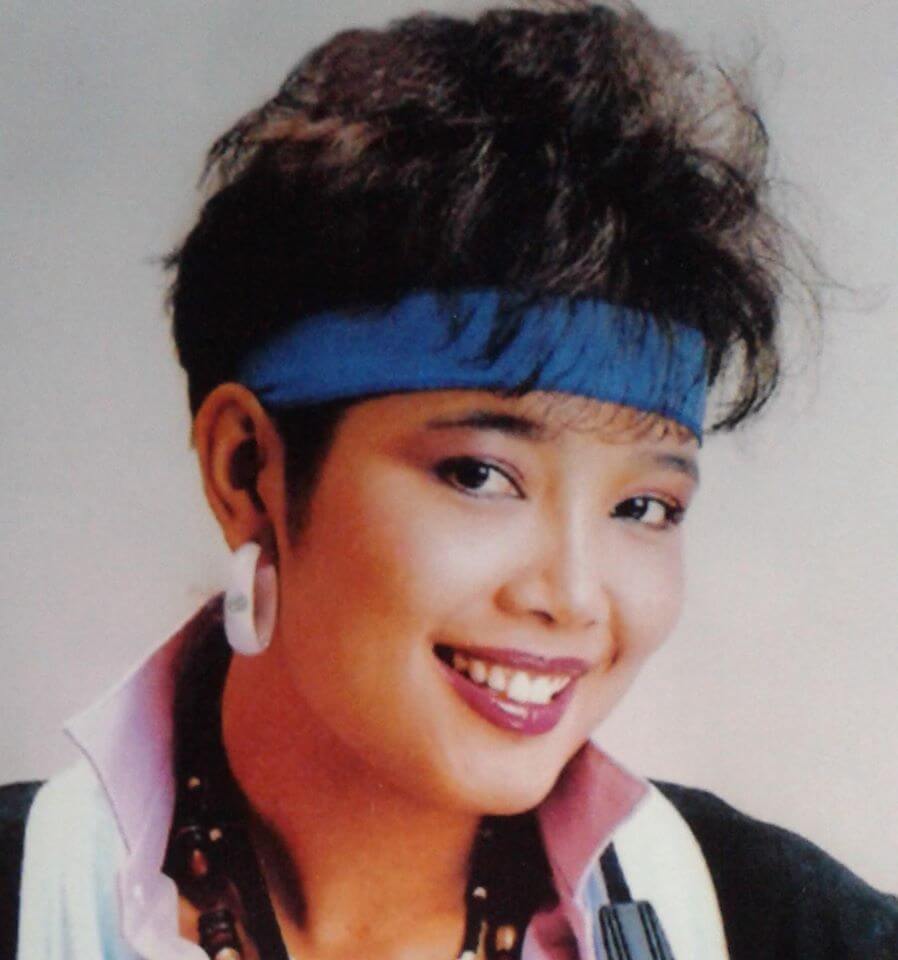
Pumpuang Duangchan (cr. Sanook)
String music is a modern genre that shares similarities with Thai pop. It is performed mostly with a string band that includes jazz, string, and electronic instruments. While Luk Thung has long been a classic genre for nearly half a century, the growing popularity of modern music such as pop, rock, and string has also influenced the evolution of Luk Thung. This new line of Luk Thung was dubbed String Luk Thung.
One of the most successful and famous Luk Thung stars of all time is Pumpuang Duangchan, who perfectly incorporated modern elements of Western music and Luk Thung’s styles into her songs. Aside from that, her music was progressive and inspiring, capturing the bold and daring characters of a new generation of women, which appealed to a wide range of listeners and helped to popularize Luk Thung among people from all backgrounds. For example, her most famous album is Aha! Lhor Jung (So Handsome!) which broke historical records with 1.5 million tape sales or worth 105 million baht in total.
Pumpuang’s music also portrays the respect and pride she has for her home, Thailand. The song Siam Mueang Yim (Land of Smile), describes the admirable qualities of Thai people, including their friendliness, kindness, welcoming smiles, and respectful attitudes toward others.
- Luk Thung Today (1993 – Present)

New Country (cr. Atime)
Similarly, while retaining some elements of its traditional musical styles, some Luk Thung artists today incorporate modern influences or other genres such as string, rock, and pop music to stay relevant to current trends.
One of the interesting examples of Luk Thung Today is the boyband “New Country” The band quickly gained popularity through their modern take on Luk Thung music. For example, while their songs often feature catchy modern elements such as English words and trendy slang among teenagers, the use of dialect and Luk Thung vocal techniques are prominent. This example, as well as works produced by other artists, help break the belief that Luk Thung’s songs are only popular among certain generations.
Although Luk Thung’s classic songs were limited to distribution through tapes and radio in the past, they have remained timeless. Today, these songs have been compiled into playlists on streaming platforms like YouTube, Apple Music, and Spotify where fans can easily find and listen to them on the playlists. Some songs have even reached millions of views, with hits from legendary artists like Suraphol Sombutchareon, Sayun Sunya, and Pumpuang Duangchan all growing up to 15 million views and counting. Many songs have also gained popularity through interactive platforms such as TikTok.
The Beauty in Luk Thung Music
Luk Thung is a love letter from the Thai people to their roots, as well as an unapologetic homage to local identities. For those living far away from their hometown, listening to Luk Thung can help them reconnect with their roots, inspiring pride and respect in their heritage. Through this mean, Luk Thung has acted as an agent of shared experience that country folks may collectively reminisce upon. As for those with different backgrounds, Luk Thung offers a glimpse into the life of people from the countryside, helping foster understanding about issues faced by rural communities and rural people working in the city. Through this, Luk Thung can also be seen as a force that promote respect among people of different backgrounds.
Today, Luk Thung remains a very much-loved music genre of the Thai people, both at home and abroad. Luk Thung’s survival can be attributed the nature of the genre which is ever-evolving and ever-growing without having to shed its roots. The fact that it opens and welcomes global influences and integrates them into the traditional style has proven that Luk Thung will continue to grow in every generation. This “openness” is an intrinsic value of Thainess and is reflected in many other aspects of Thai culture and heritage.
In conclusion, Luk Thung embodies the spirit and pride of the Thai countryside. It reconnects listeners with their home and uplifts them during difficult times. It sheds light on the lives of country folks, helping to promote respect and understanding. Its openness to embrace new influences has allowed it remain a dynamic and exciting genre. To see Luk Thung’s evolution and growth while staying true to its roots is what Thai people are proud of. It is a testament that Luk Thung’s value goes beyond music.
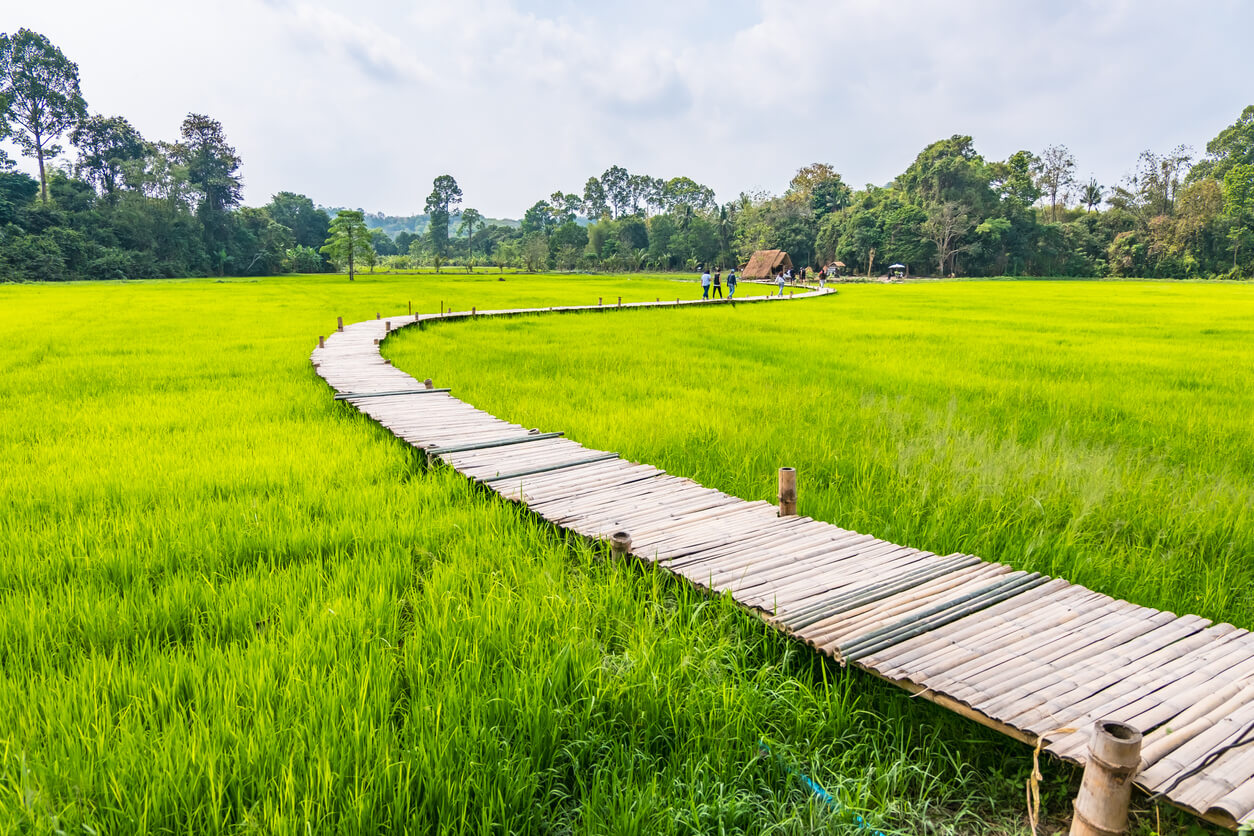
(cr. Expedia)
The story of “Phleng Luk Thung” is a colorful part of Thai culture and heritage. We saw how the essence of Thainess is represented through pride in local identity, respect for people from different walks of life, and openness in artistic expression. Join us in exploring more stories of Thailand and the Thai people, as we take you on a journey to discover Thainess.
Sources:
- https://bit.ly/3jufoaL
- https://bit.ly/3Rpi321
- https://saranukromthai.or.th/sub/book/book.php?book=33&chap=2&page=t33-2-infodetail01.html
- https://lannainfo.library.cmu.ac.th/kammuangmusic.php
- https://www.saranukromthai.or.th/sub/book/book.php?book=33&chap=2&page=t33-2-infodetail02.html
- https://bit.ly/3HPfseq
- https://www.saranukromthai.or.th/sub/book/book.php?book=33&chap=2&page=t33-2-infodetail10.html
- https://www.finearts.go.th/surinmuseum/view/11369-%E0%B8%81%E0%B8%B1%E0%B8%99%E0%B8%95%E0%B8%A3%E0%B8%B6%E0%B8%A1
- http://dcms.lib.nu.ac.th/dcms/0001-04172/00442/chapter4.pdf
- https://en.wikipedia.org/wiki/Eua_Sunthornsanan
- https://www.chiangmainews.co.th/entertainment/2056630/
- https://music.trueid.net/th-th/detail/eva8pjRxnO1N
- https://www.isangate.com/new/looktung-and-morlum.html
- https://www.isangate.com/new/khmer/15-art-culture/artist/821-darkie.html
- https://so05.tci-thaijo.org/index.php/rusamelae/article/download/107181/84816/272725
Author: Pranaiya Panthanuwong
Editor: Tayud Mongkolrat
8 June 2023


